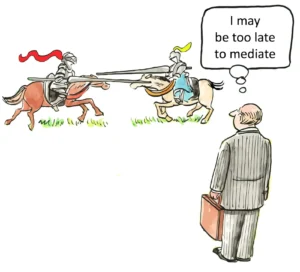Business Partnership Disputes: Legal Resolution Strategies
Business partnership disputes can arise unexpectedly, threatening the stability and success of even the most promising ventures. When conflicts between partners escalate beyond simple disagreements, it becomes crucial to implement effective legal resolution strategies to protect the interests of all parties involved and preserve the viability of the business. This article examines various approaches to resolving partnership disputes, from negotiation and mediation to more formal legal proceedings, providing insights into the complex landscape of partnership law and dispute resolution.
At the core of many partnership disputes lies a fundamental misalignment of expectations, goals, or values among the partners. These conflicts can stem from a variety of sources, including disagreements over financial management, strategic direction, operational decisions, or perceived inequities in workload or compensation. Left unaddressed, such disputes can quickly escalate, leading to a breakdown in communication, erosion of trust, and potential damage to the business itself.
One of the first steps in addressing a partnership dispute is to review the partnership agreement, if one exists. This document serves as the foundational contract governing the relationship between partners and often includes provisions for dispute resolution. A well-drafted partnership agreement can provide a roadmap for addressing conflicts, outlining specific procedures and mechanisms for resolving disagreements before they escalate into full-blown legal battles.
In the absence of a comprehensive partnership agreement, or when the existing agreement proves insufficient to address the specific nature of the dispute, partners may need to explore alternative methods of resolution. Negotiation often serves as the initial approach, with partners attempting to resolve their differences through direct communication and compromise. This process can be facilitated by legal counsel, who can help articulate each partner’s position, identify potential areas of agreement, and work towards a mutually acceptable solution.
When direct negotiations fail to yield results, partners may turn to mediation as a next step. Mediation involves a neutral third party who facilitates discussions between the disputing partners, helping to identify common ground and explore potential resolutions. The mediator does not impose a decision but rather assists the parties in reaching their own agreement. This process can be particularly effective in preserving business relationships, as it encourages open communication and collaborative problem-solving.
If mediation proves unsuccessful, arbitration may be the next option to consider. Arbitration is a more formal process than mediation, involving a neutral arbitrator who hears arguments from both sides and renders a binding decision. This approach can be faster and less expensive than traditional litigation, while still providing a structured forum for resolving complex disputes. Many partnership agreements include arbitration clauses, specifying that certain types of disputes must be resolved through this process.
In cases where alternative dispute resolution methods fail to resolve the conflict, partners may need to resort to litigation. While often viewed as a last resort due to its potential for high costs, lengthy timelines, and adversarial nature, litigation may be necessary in situations involving allegations of fraud, breach of fiduciary duty, or other serious misconduct. The litigation process allows for a full examination of the facts through discovery, presentation of evidence, and ultimately, a binding decision by a judge or jury.
One critical aspect of partnership dispute resolution is the concept of fiduciary duty. Partners owe each other a fiduciary duty, which includes obligations of loyalty, good faith, and fair dealing. Breaches of fiduciary duty can form the basis for legal action and may significantly impact the outcome of a dispute. Examples of fiduciary duty breaches include self-dealing, misappropriation of partnership opportunities, or failure to disclose material information to other partners.
The Uniform Partnership Act (UPA) and its revised version, the Revised Uniform Partnership Act (RUPA), provide a legal framework for partnerships in many jurisdictions. These acts address various aspects of partnership formation, operation, and dissolution, including provisions for resolving disputes. Understanding the applicable partnership laws in your jurisdiction is crucial when navigating a partnership dispute, as these laws can significantly influence the rights and obligations of partners in conflict situations.
One emerging trend in partnership dispute resolution is the use of collaborative law techniques. This approach involves a commitment by all parties and their attorneys to work cooperatively towards a resolution without resorting to litigation. Collaborative law emphasizes open communication, transparency, and problem-solving, often involving neutral experts to assist with financial, operational, or other technical aspects of the dispute.
Another important consideration in partnership disputes is the potential impact on the business itself. Prolonged conflicts can divert resources, damage relationships with clients or suppliers, and create uncertainty that hampers business operations. As such, dispute resolution strategies should always consider the broader implications for the business and seek to minimize disruption to ongoing operations.
In some cases, the resolution of a partnership dispute may involve a buyout of one or more partners’ interests. This can be a complex process, requiring careful valuation of the business and negotiation of terms. Buyout provisions in the partnership agreement can provide a framework for this process, but in the absence of such provisions, partners may need to engage in extensive negotiations or seek court intervention to determine fair terms.
The concept of partnership dissolution may also come into play in severe disputes. While dissolution is often viewed as a last resort, it may be necessary in situations where the partners can no longer work together effectively or where the business is no longer viable. The process of dissolution involves winding up the partnership’s affairs, liquidating assets, paying creditors, and distributing any remaining assets among the partners. This process can be complex and contentious, often requiring legal intervention to ensure fair and equitable treatment of all partners.
Alternative dispute resolution (ADR) methods have gained increasing prominence in resolving partnership disputes. These methods, including mediation and arbitration, offer several advantages over traditional litigation. They are often faster, less expensive, and allow for more creative and flexible solutions. Additionally, ADR processes can be conducted confidentially, helping to preserve business relationships and protect sensitive information from public disclosure.
The role of corporate governance in preventing and resolving partnership disputes should not be overlooked. Establishing clear decision-making processes, implementing robust financial controls, and maintaining transparent communication channels can help prevent many common sources of conflict. Regular partnership meetings, clear documentation of decisions and agreements, and periodic reviews of the partnership agreement can all contribute to a more stable and harmonious business relationship.
In the context of limited liability partnerships (LLPs) and limited liability companies (LLCs), dispute resolution may involve additional complexities. These business structures often have more formalized governance structures and may be subject to specific statutory requirements regarding dispute resolution. Understanding the nuances of these business forms is crucial when addressing conflicts in these contexts.
The impact of technology on partnership disputes and their resolution is an evolving area of consideration. Digital communication platforms, cloud-based document storage, and electronic financial systems can all play a role in both the genesis of disputes and their resolution. For example, disputes may arise over access to digital assets or the interpretation of electronic communications. Conversely, technology can also facilitate more efficient dispute resolution processes, such as online mediation or virtual arbitration hearings.
Intellectual property issues can be a significant source of partnership disputes, particularly in technology-driven or creative industries. Disagreements may arise over ownership of patents, trademarks, or copyrights developed during the course of the partnership. Resolving these disputes often requires specialized knowledge and may involve complex valuation issues. Clear agreements regarding intellectual property ownership and licensing should be established at the outset of a partnership to minimize the potential for future conflicts.
The concept of partnership equity is often at the heart of many disputes. This encompasses not only financial contributions but also sweat equity, intellectual property contributions, and other non-monetary inputs that partners bring to the business. Disputes may arise when partners perceive inequities in the recognition or valuation of these contributions. Addressing these issues often requires a nuanced approach that considers both tangible and intangible factors.
In international partnerships, cross-border dispute resolution adds another layer of complexity. Different legal systems, cultural norms, and business practices can complicate the resolution process. International arbitration has emerged as a popular method for resolving cross-border partnership disputes, offering a neutral forum and enforceable decisions across multiple jurisdictions.
The role of insurance in partnership disputes is an often-overlooked aspect of risk management. Directors and Officers (D&O) insurance, for example, can provide protection for partners in the event of legal action. Understanding the scope and limitations of such insurance policies is crucial for partners seeking to mitigate their personal risk in the event of a dispute.
Tax implications of partnership disputes and their resolution can be significant and should be carefully considered in any resolution strategy. For example, buyouts or dissolutions may trigger tax liabilities for the partners involved. Consulting with tax professionals early in the dispute resolution process can help partners understand and plan for potential tax consequences.
The impact of external stakeholders on partnership disputes should not be underestimated. Creditors, key employees, major clients, or regulatory bodies may all have interests that need to be considered in the resolution process. In some cases, these stakeholders may even need to be involved in the resolution discussions to ensure a comprehensive and sustainable solution.
Ethical considerations play a crucial role in partnership dispute resolution. Legal and business ethics intersect in complex ways when partners are in conflict. Issues such as conflicts of interest, confidentiality, and fair dealing must be carefully navigated. Attorneys involved in partnership disputes must be particularly attuned to these ethical dimensions, ensuring that their representation does not compromise their professional obligations.
The psychological and emotional aspects of partnership disputes can significantly influence the resolution process. Conflict resolution skills and emotional intelligence are valuable assets for partners and their advisors when navigating these challenging situations. Recognizing and addressing the emotional components of a dispute can often be key to reaching a satisfactory resolution.
In conclusion, resolving business partnership disputes requires a multifaceted approach that considers legal, financial, operational, and interpersonal factors. While the specific strategies employed will depend on the nature of the dispute and the unique circumstances of the partnership, a thoughtful and proactive approach to conflict resolution can help partners navigate even the most challenging situations. By leveraging a combination of clear agreements, alternative dispute resolution methods, and, when necessary, formal legal processes, partners can work towards resolutions that protect their interests, preserve valuable business relationships, and position their ventures for future success.
- https://www.eeoc.gov/age-discrimination
- https://www.dol.gov/agencies/oasam/centers-offices/civil-rights-center/internal/policies/age-discrimination
- https://www.aarp.org/politics-society/advocacy/info-2024/workplace-age-discrimination-still-pervasive.html
- https://www.workplacefairness.org/age-discrimination
- https://www.americanbar.org/groups/crsj/publications/human_rights_magazine_home/the-state-of-healthcare-in-the-united-states/racial-disparities-in-health-care/
- https://www.ncsl.org/labor-and-employment/age-discrimination-in-employment-act-adea














![Life Insurance – The Ultimate Estate Planning Tool [Video] - Attorneys.Media - Legal Expert Interviews & Trusted Advice Watch: Life Insurance – the Ultimate Estate Planning Tool with Andrew Dósa – Tacoma & Oakland](https://b3514829.smushcdn.com/3514829/wp-content/uploads/2025/09/life-insurance-form-SBI-300194206-300x200.jpg?lossy=2&strip=1&webp=1)





